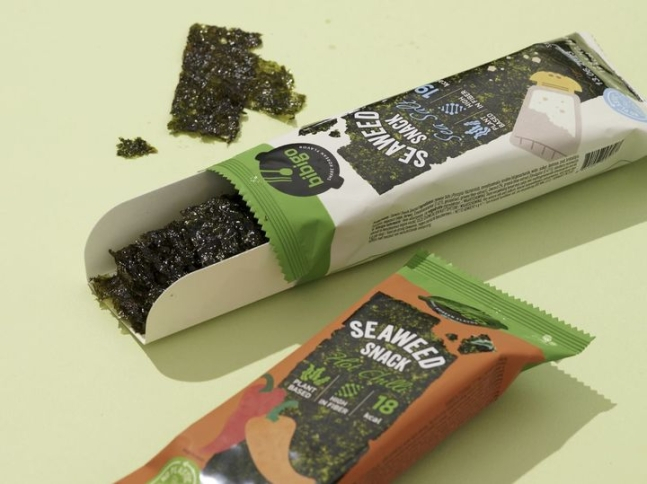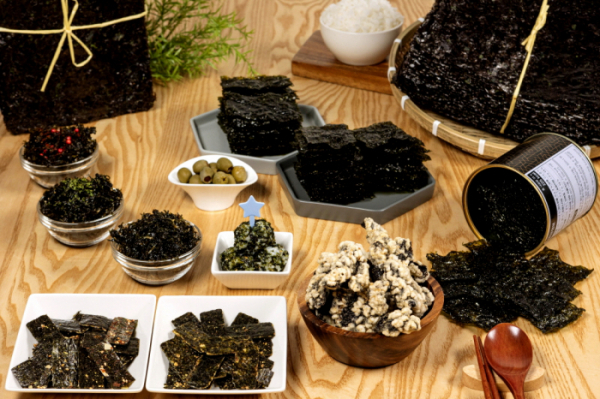Korean food
South Koreans puzzled over rising seaweed prices despite bumper crop
Demand is so high that Korea plans to create new seaweed farms equal to 3,800 soccer fields this year
By Sep 02, 2024 (Gmt+09:00)
3
Min read
Most Read
Samsung steps up AR race with advanced microdisplay for smart glasses


When in S. Korea, it’s a ritual: Foreigners make stops at CU, GS25, 7-Eleven


Maybe Happy Ending: A robot love story that rewrote Broadway playbook


NPS yet to schedule external manager selection; PE firms’ fundraising woes deepen


US auto parts tariffs take effect; Korea avoids heavy hit



Dried seaweed prices are rising at a fast pace despite handsome growth in production, leaving South Koreans puzzled over what is behind the steep price hikes.
According to the Korea Agro-Fisheries & Food Trade Corp. (aT) on Monday, the wholesale price of dried seaweed, widely used to make kimbap, or seaweed-wrapped rice rolls, stood at 10,780 won ($8.1) per sog, a Korean term that refers to 100 sheets, as of Aug. 30, up 59.4% from 6,764 won a year earlier.
Retail prices rose 33.4% over the same period to 1,365 won per 10 sheets.
Distribution industry officials pointed to the increasing volume of exports to Japan as a possible reason, but government officials downplayed it, saying that the rise in dried seaweed export volume to Japan is insignificant compared to the production volume.
According to the Ministry of Oceans and Fisheries, seaweed production so far this year reached 149.7 million sog, up 6% from a year earlier.
Nevertheless, seaweed prices have steadily increased amid a lack of inventories.
Korea Maritime Institute (KMI) data showed the inventory of laver, called gim or kim in Korean, was 33 million sog at the end of June, down 26.7% from a year earlier. The latest figure is 45.8% lower than the five-year average.

RISING EXPORTS TO JAPAN
Korea’s seaweed inventory is depleting due largely to growing exports.
Dried seaweed exports in the first half of this year stood at 19,346 tons or about 55% of last year’s entire exports of 35,446 tons.
Exports to Japan grew at the fastest pace.
According to the KMI, Korea’s dried seaweed exports to Japan in the three months from May were 2.89 million kilograms, up 33.1% from 2.17 million kilograms.
Export prices were $30.68 per kilogram in the May-July period, up 49.6% from $20.51 a year earlier.
The export value was $88.64 million, up 99.1% from $44.52 million.
The Ministry of Oceans and Fisheries said rising dried seaweed exports to Japan are not the only reason for higher domestic prices.
Japan's import volume of Korean seaweed is only about one-fifteenth of Korea’s annual production of 150 million sog.

Food industry officials said the rising popularity of K-food worldwide and the increase in frozen kimbap exports are also contributing to higher domestic seaweed prices.
Seaweed exports are expected to continue increasing.
In 2015, the Japanese government agreed to gradually increase its Korean seaweed imports from 1.2 billion sheets in 2015 to 2.7 billion sheets by 2025.
Korea’s oceans ministry plans to create new seaweed farms equivalent to the size of 3,800 soccer fields, or 2,700 hectares, this year.
BLACK SEMICONDUCTOR
Dried seaweed is often referred to as the “black semiconductor” in Korea these days – an amusing reference to dark seaweed, the price of which has risen so high that seaweed exports are said to be boosting the Korean economy as much as semiconductor chips.
Analysts said the global fever over Korean food or K-food, including kimbap, also romanized as "gimbap," has led to a gim supply shortage, driving gim prices higher.
The country’s exports of dried seaweed reached a record 1.03 trillion won, or $790 million, in 2023, up 22% from the previous year, according to the Korea Customs Service.
Korea dominates the global seaweed market with a 70.6% market share as of 2022.
Write to Kwang-Sik Lee at bumeran@hankyung.com
In-Soo Nam edited this article.
More to Read
-
 Korean foodFrozen kimbap market emerges as new K-food battlefield
Korean foodFrozen kimbap market emerges as new K-food battlefieldJun 14, 2024 (Gmt+09:00)
2 Min read -
 Korean foodSeaweed, dubbed ‘Korea’s black semiconductor,’ powers its economy
Korean foodSeaweed, dubbed ‘Korea’s black semiconductor,’ powers its economyMay 24, 2024 (Gmt+09:00)
2 Min read -
 EconomyIn Korean food prices, everything’s up: Now it’s dried seaweed's turn
EconomyIn Korean food prices, everything’s up: Now it’s dried seaweed's turnApr 18, 2024 (Gmt+09:00)
3 Min read -
 Korean foodAfter frozen Kimbap craze, here comes Korean street food
Korean foodAfter frozen Kimbap craze, here comes Korean street foodFeb 01, 2024 (Gmt+09:00)
3 Min read -

Comment 0
LOG IN


